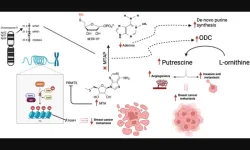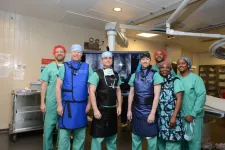(Press-News.org) Researchers at Tufts University School of Medicine and colleagues have identified a small molecule that may help treat people with epilepsy whose condition has become resistant to the benzodiazepine drugs usually used in managing seizures. The research, conducted in laboratory cells and rodents, was published online March 7 in Cell Reports Medicine.
Uncontrolled epilepsy can lead to frequent and prolonged seizures lasting five minutes or more that can cause brain cell damage and even death. The condition affects an estimated 3.4 million people in the U.S. and millions more worldwide.
Epilepsy occurs when the intricate, delicate balance of signaling by neurons in the brain malfunctions, causing neurons to fire too much and trigger seizures. Benzodiazepines slow down the messages traveling between neurons.
“While seizures can frequently be controlled with medications, up to 30 percent of those with epilepsy develop drug resistance after a period of time,” says study co-first author Krithika Abiraman, a scientist in the Department of Neuroscience at Tufts University School of Medicine.
The scientists were looking for targets in the brain that could restore normal signaling. They focused on a potassium chloride co-transporter called KCC2. In the normal brain, KCC2 helps pump chloride out of nerve cells, which helps brake neuronal overfiring.
“Previous research in both rodents and humans had shown that low KCC2 levels and activity in the brain is linked to drug-resistant and prolonged seizures,” explains Shu Fun Josephine Ng, co-first author and a scientist in the Department of Neuroscience. Both Ng and Abiraman work in the laboratory of Stephen Moss, professor of neuroscience at the School of Medicine, program faculty at Tufts Graduate School of Biomedical Sciences, and corresponding author on the study.
Collaborators at AstraZeneca screened more than one million compounds to identify a family of compounds that might be able to affect the activity of KCC2 in the brain.
The scientists tested one of the compounds in that family – Compound 350 – and observed that in combination with benzodiazepine, the Compound 350 reduced seizure activity in rodents with drug-resistant seizures.
“We also observed that mice treated with the benzodiazepine and Compound 350 had lower cell death in the brain than those treated only with the benzodiazepine,” said Ng, adding that this was most likely because rodents treated with both drugs were not having as many seizures.
“The small molecules we have identified have the capacity to be developed as first-in-class drugs to alleviate drug-resistant epilepsies and neurodegenerative disorders,” says Moss. “In collaboration with Ovid Therapeutics, these compounds are now under clinical development.”
Citation: Research reported in this article was supported by the National Institutes of Health’s National Institute of Neurological Disorders and Stroke under awards NS087662, NS081986, NS108378, NS101888, NS103865, NS111338; by the National Institute of Mental Health under award MH118263; and by the AstraZeneca Postdoctoral Program. Complete information on authors, funders, and conflicts of interest is available in the published paper.
DISCLAIMER: The content is solely the responsibility of the authors and does not necessarily represent the official views of the funders.
END
Potential treatment target for drug-resistant epilepsy identified
A new study by Tufts University researchers found a molecule that could be a target for treatment in patients who have become resistant to traditional anti-seizure drugs
2023-03-14
ELSE PRESS RELEASES FROM THIS DATE:
New model provides improved air-quality predictions in fire-prone areas
2023-03-14
UNIVERSITY PARK, Pa. — Globally, wildfires are becoming more frequent and destructive, generating a significant amount of smoke that can be transported thousands of miles, driving the need for more accurate air pollution forecasts. A team of Penn State researchers developed a deep learning model that provides improved predictions of air quality in wildfire-prone areas and can differentiate between wildfires and non-wildfires.
“As climate change continues to cause ecological changes and challenges, it is likely that wildfire ...
New study finds early warning signs prior to 2002 Antarctic ice shelf collapse
2023-03-14
UNIVERSITY PARK, Pa. — In 2002, an area of ice about the size of Rhode Island dramatically broke away from Antarctica as the Larsen B ice shelf collapsed. A new study of the conditions that led to the collapse may reveal warning signs to watch for future Antarctic ice shelf retreat, according to a Penn State-led team of scientists.
“The collapse of the Larsen B ice shelf is generally thought of as an independent event,” said Shujie Wang, assistant professor of geography at Penn State. “Our ...
Oncotarget | MTAP loss in metastatic breast cancer patients: Genomic landscape
2023-03-14
“In breast cancer, MTAP downregulation activates ornithine decarboxylase (ODC) which in turn leads to formation of putrescine which promotes tumor migration, invasion and angiogenesis [15].”
BUFFALO, NY- March 14, 2023 – A new research paper was published in Oncotarget's Volume 14 on March 11, 2023, entitled, “Genomic landscape of metastatic breast cancer (MBC) patients with methylthioadenosine phosphorylase (MTAP) loss.”
Homozygous deletion of methylthioadenosine phosphorylase (MTAP) upregulates de novo synthesis ...
Tim Michalski selected as Jefferson Lab’s engineering manager
2023-03-14
NEWPORT NEWS, VA – The U.S. Department of Energy’s (DOE) Thomas Jefferson National Accelerator Facility has selected Tim Michalski to lead its Engineering Division as the Engineering Division Manager. In this role, Michalski oversees all aspects of the management and operation of the Engineering Division. The division includes more than 200 staff members and supports the Continuous Electron Beam Accelerator Facility and the lab’s growing project portfolio.
“I am proud to name Tim as our newest Engineering Division Manager,” said Jefferson Lab Director Stuart Henderson. “Tim has ...
Princeton Chem, IAS uncover spatial patterns in distribution of galaxies
2023-03-14
In late 2021, Salvatore Torquato, on sabbatical from Princeton’s Department of Chemistry, reached across the aisle as it were and invited a young astrophysicist at the Institute for Advanced Study to apply the tools of statistical mechanics to his own work on the distribution of galaxies.
The astrophysicist, Oliver Philcox, now a postdoc at the Simons Foundation, was intrigued. A year-long collaboration ensued.
The questions at the heart of their unusual partnership were straightforward: can the statistical descriptors Torquato has worked with throughout his career find application in unlikely places like cosmology, and can they accurately characterize the complexity in the distribution ...
Researchers look to AI for decision-making in extreme situations
2023-03-14
Imagine you are a doctor managing the emergency room of a large hospital. You suddenly get a call reporting a mass shooting at a nearby concert. In 20 minutes, you will be responsible for triaging more than 200 patients with a range of injuries. You do not have enough staff or resources and the hospital policies are not designed for a situation this dire.
“When people respond to emergencies, many decisions they face are quite predictable. They’re trained on them, and there’s policy,” said UMass Lowell’s Neil Shortland, associate professor in the School of Criminology and Justice Studies. “But every now and then, they get stuck with a really ...
Mix-and-match kit could enable astronauts to build a menagerie of lunar exploration bots
2023-03-14
When astronauts begin to build a permanent base on the moon, as NASA plans to do in the coming years, they’ll need help. Robots could potentially do the heavy lifting by laying cables, deploying solar panels, erecting communications towers, and building habitats. But if each robot is designed for a specific action or task, a moon base could become overrun by a zoo of machines, each with its own unique parts and protocols.
To avoid a bottleneck of bots, a team of MIT engineers is designing a kit of universal ...
Common dry cleaning chemical linked to Parkinson’s
2023-03-14
A common and widely used chemical may be fueling the rise of the world’s fastest growing brain condition – Parkinson’s disease. For the past 100 years, trichloroethylene (TCE) has been used to decaffeinate coffee, degrease metal, and dry clean clothes. It contaminates the Marine Corps base Camp Lejeune, 15 toxic Superfund sites in Silicon Valley, and up to one-third of groundwater in the U.S. TCE causes cancer, is linked to miscarriages and congenital heart disease, and is associated ...
Molecular component of caffeine may play a role in gut health
2023-03-14
Brigham researchers studying how and why certain cell types proliferate in the gut found that xanthine, which is found in coffee, tea and chocolate, may play a role in Th17 differentiation
Insights may help investigators better understand gut health and the development of conditions such as inflammatory bowel disease
The gut is home to a cast of microbes that influence health and disease. Some types of microorganisms are thought to contribute to the development of inflammatory conditions, such as inflammatory bowel disease (IBD), but the exact cascade of events that leads from microbes to immune cells to disease remains ...
Ochsner Health announces new Aortic Center; subscribes to cutting-edge imaging with Cydar Technology
2023-03-14
NEW ORLEANS, La. – Global death rates from aortic diseases have steadily increased over the past two decades. Studies show up to 8% of individuals will develop an aortic aneurysm during their lifetime, higher than rates of colon and lung cancer combined, and over 80% of ruptured aortic aneurysms cause sudden death.
To save lives and improve outcomes for patients with aortic disease of all kinds, Ochsner Health is excited to announce the establishment of The Ochsner Aortic Center. Outfitted with cutting-edge imaging technology that allows medical staff to make faster, easier, and safer decisions, this dedicated, comprehensive aortic center is now the ...
LAST 30 PRESS RELEASES:
New microfluidics technology enables highly uniform DNA condensate formation
A new strategy for immune tolerance
Super Mario Bros. help fight burnout: New study links classic games to boosted happiness
Deepest gas hydrate cold seep ever discovered in the arctic: International research team unveils Freya Hydrate Mounds at 3,640 m depth.
Integrating light and structure: Smarter mapping for fragile wetland ecosystems
ACA-SIM: A robust way to decode satellite signals over complex waters
Probiotics can restore gut microbiome in breastfed infants
AI could help predict nutrition risks in ICU patients, study finds
Federal EITC has unexpected result, researchers say – it decreases domestic violence
Researchers identify gene that calms the mind and improves attention in mice
Artificial metabolism turns waste CO2 into useful chemicals
Ancient sea anemone sheds light on animal cell type evolution
Begging gene leads to drone food
How climate policies that incentivize and penalize can drive the clean energy transition
Can community awareness campaigns in low-resource areas improve early diagnosis of colorectal cancer?
Stardust study resets how life’s atoms spread through space
Practical education: Clinical scenario-based program development
The impact of family dynamics on eating behaviour – how going home for Christmas can change how you eat
Tracing the quick synthesis of an industrially important catalyst
New software sheds light on cancer’s hidden genetic networks
UT Health San Antonio awarded $3 million in CPRIT grants to bolster cancer research and prevention efforts in South Texas
Third symposium spotlights global challenge of new contaminants in China’s fight against pollution
From straw to soil harmony: International team reveals how biochar supercharges carbon-smart farming
Myeloma: How AI is redrawing the map of cancer care
Manhattan E. Charurat, Ph.D., MHS invested as the Homer and Martha Gudelsky Distinguished Professor in Medicine at the University of Maryland School of Medicine
Insilico Medicine’s Pharma.AI Q4 Winter Launch Recap: Revolutionizing drug discovery with cutting-edge AI innovations, accelerating the path to pharmaceutical superintelligence
Nanoplastics have diet-dependent impacts on digestive system health
Brain neuron death occurs throughout life and increases with age, a natural human protein drug may halt neuron death in Alzheimer’s disease
SPIE and CLP announce the recipients of the 2025 Advanced Photonics Young Innovator Award
Lessons from the Caldor Fire’s Christmas Valley ‘Miracle’
[Press-News.org] Potential treatment target for drug-resistant epilepsy identifiedA new study by Tufts University researchers found a molecule that could be a target for treatment in patients who have become resistant to traditional anti-seizure drugs





